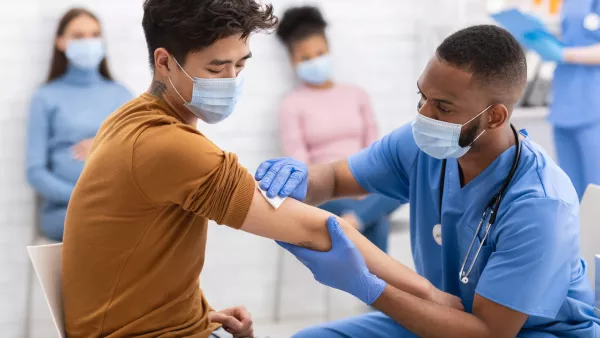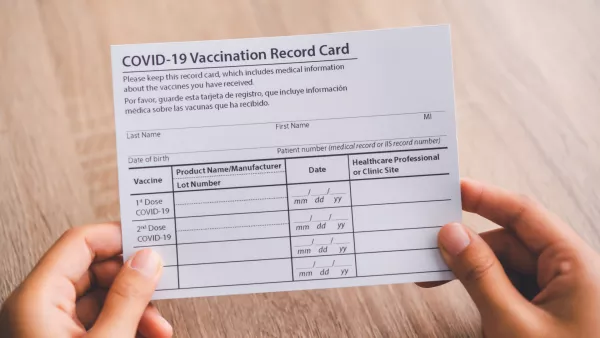
Making strides in the vaccination effort
In the United States, more than 319 million COVID-19 vaccines have been administered as of June 23, according to the Centers for Disease Control and Prevention (CDC) COVID Data Tracker. While 56% of U.S. adults are fully vaccinated, about 65% have had at least one dose.
Across the country, many Greenway clients have joined the effort, taking on vaccine administration in addition to their practice’s usual work. It is an honor to serve incredible healthcare practices and an inspiration to hear of their efforts on the front lines in the battle against COVID-19.
“We partnered with a local pharmacy for a week to help increase vaccination numbers. We also reached out to our local partners to inform them that the vaccine is available at our clinic.”Kendra Peterson, Systems Analyst II, Hamilton Health Center in Harrisburg, Pa.
For example, Hamilton Health Center in Harrisburg, Pa., created a special department and recruited staff to handle vaccine-related tasks — from scheduling vaccine appointments to administering doses.
“We partnered with a local pharmacy for a week to help increase vaccination numbers,” said Kendra Peterson, Systems Analyst II. “We also reached out to our local partners to inform them that the vaccine is available at our clinic.”
Targeting low vaccination areas
ConnextCare, based in Pulaski, N.Y., tapped into data to find the best locations for its vaccine clinics.
“We have been running reports and dashboards through Practice Analytics to determine low areas of vaccination rates around our health centers and setting up vaccine clinics,” said Suzy Miller, Information Services Manager.
To ensure no vaccine appointments go to waste, the practice keeps a list of 10-15 people near each clinic who can be called to come in if there’s a cancellation or no-show.
Area schools are another location where ConnextCare provides vaccines. The clinic recently partnered with local school districts in Upstate New York to set up immunization clinics to vaccinate students.
Overcoming healthcare disparities: Vaccination in rural areas
Rural communities have been at risk amid the pandemic due to healthcare disparities related to limited access to primary care, specialists, and emergency or critical care facilities. There are also disparities when it comes to vaccine rates in rural communities compared to urban ones.
Community Health Centers of Northeast Oklahoma used a multi-faceted approach to raise awareness of vaccine availability among its rural patient population. This included emails to large local companies and postcards sent throughout the surrounding areas.
Additionally, the practice sent broadcast texts and phone calls through Greenway Patient Messaging to encourage patients to spread the word to friends and family. This strategy proved effective, resulting in a spike in vaccine appointments.
While the practice still saw a lower volume of vaccination compared to its urban counterparts, it’s been able to vaccinate patients from more populated areas who had a difficult time getting vaccinated at their local clinics due to volume.
“In the end, it worked out well for people wanting to get vaccinated without having to wait as long,” said Shandi Guertin, LPN, Informatics and Telehealth Coordinator.
Administering COVID-19 vaccines to tribal communities — and beyond
Racial and ethnic minority groups are another population that faces healthcare inequities that lead to increased risk of COVID-19.
The Indian Health Service (IHS) details how COVID-19 has disproportionately affected American Indians and Alaskan Natives:
- This population has infection rates over 3.5 times higher than non-Hispanic whites.
- They are over four times more likely to be hospitalized as a result of COVID-19.
- They have higher rates of mortality at younger ages than non-Hispanic whites.
By early April 2021, the American Indian and Alaskan Native population had higher vaccination rates compared to other racial or ethnic groups, with 32% of this population already having received at least one dose of the vaccine.
Researchers have attributed the success of vaccine administration across the Indian health system to the IHS having the autonomy to determine vaccine priority strategies for its unique population, such as prioritizing fluent Native language speakers to preserve this part of the culture.
Nottawaseppi Huron Band of the Potawatomi (NHBP) in Michigan had vaccines available before most health systems. In addition, the tribal health clinic vaccinated its elderly and higher risk populations at a faster rate than the national average.
“NHBP has been making great strides in vaccinating the tribal communities as well as surrounding communities.”Andrew Straatsma, Business Office Manager, Nottawaseppi Huron Band of the Potawatomi (NHBP)
“That is due to having the flexibility to administer vaccines as we see fit and in accordance with IHS standards,” said Andrew Straatsma, Business Office Manager. “We have been given great leeway to make this process as easy as possible for those who would like to be vaccinated.”
NHBP set up a vaccine hotline for tribal members to schedule vaccine appointments at its three sites. The clinic offered vaccines to any tribal member, not just NHBP members. Individuals came from as far as Cincinnati, over five hours away, to receive the vaccine.
The clinic has extended its efforts beyond tribal communities. It opened its doors to family members of practice staff to get the vaccine and launched a community vaccine clinic for its traditionally underserved rural community. In addition, many clinical staff members have volunteered at state vaccine clinics.
“NHBP has been making great strides in vaccinating the tribal communities as well as surrounding communities,” Andrew said.
Spreading the word to improve vaccination rates
Even practices that don’t offer the COVID-19 vaccine have made it a priority to talk to patients about it.
At Medical Colleagues of Texas, practice staff members take time at each appointment to educate patients on the vaccine and address any questions and concerns.
“Our community vaccination rates are increasing every day.”Ethan Bing, Practice Administrator, Medical Colleagues of Texas
“We then direct them to the local community vaccination clinics if they state they would like the vaccine,” said Ethan Bing, Practice Administrator. “Our community vaccination rates are increasing every day.”
North Central Arkansas Medical Associates, P.A., has ordered the vaccine but is still waiting to receive it. In the meantime, staff members have initiated conversations with patients about the vaccine, finding out whether they’re vaccinated, and referring them to the CDC for more information.
Ormond Pediatrics, P.A., uses its website to link to vaccinefinder.org, where patients can search for a nearby location to get the vaccine.
“We have been speaking with patients of age to receive the vaccine. We give directions to select the Pfizer vaccine as that is the only one approved for our patient population,” said Jennifer Danver, Office Manager.
Greenway is honored to help support these and other clients that are going above and beyond to administer COVID-19 vaccines in creative, innovative ways — helping their patient populations, communities, and beyond!



